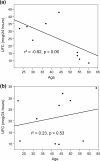Altered Pituitary Gland Structure and Function in Posttraumatic Stress Disorder
- PMID: 29264511
- PMCID: PMC5686623
- DOI: 10.1210/js.2017-00069
Altered Pituitary Gland Structure and Function in Posttraumatic Stress Disorder
Abstract
Objectives: Posttraumatic stress disorder (PTSD) is associated with hypothalamus-pituitary-adrenal (HPA) axis response to stressors, but links to neurophysiological and neuroanatomical changes are unclear. The purpose of this study was to determine whether stress-induced cortisol alters negative feedback on pituitary corticotroph function and pituitary volume.
Design: Prospective controlled study in an outpatient clinic.
Methods: Subjects with PTSD and matched control subjects underwent pituitary volume measurement on magnetic resonance imaging, with pituitary function assessed by 24-hour urine free cortisol (UFC), 8:00 am cortisol, and adrenocorticotropic hormone (ACTH) levels, and ACTH levels after 2-day dexamethasone/corticotropin-releasing hormone test. Primary outcome was pituitary volume; secondary outcomes were ACTH area under the curve (AUC) and 24-hour UFC.
Results: Thirty-nine subjects were screened and 10 subjects with PTSD were matched with 10 healthy control subjects by sex and age. Mean pituitary volume was 729.7 mm3 [standard deviation (SD), 227.3 mm3] in PTSD subjects vs 835.2 mm3 (SD, 302.8 mm3) in control subjects. ACTH AUC was 262.5 pg/mL (SD, 133.3 pg/mL) L in PTSD vs 244.0 pg/mL (SD, 158.3 pg/mL) in control subjects (P = 0.80). In PTSD subjects, UFC levels and pituitary volume inversely correlated with PTSD duration; pituitary volume correlated with ACTH AUC in control subjects (Pearson correlation coefficient, 0.88, P = 0.0009) but not in PTSD subjects.
Conclusions: The HPA axis may be downregulated and dysregulated in people with PTSD, as demonstrated by discordant pituitary corticotroph function and pituitary volume vs intact HPA feedback and correlation of pituitary volume with ACTH levels in healthy control subjects. The results suggest a link between pituitary structure and function in PTSD, which may point to endocrine targeted therapeutic approaches.
Keywords: PTSD; cortisol; hypothalamic-pituitary-adrenal axis; pituitary gland; pituitary volume.
Figures



Similar articles
-
Sleep and hypothalamic pituitary adrenal axis responses to metyrapone in posttraumatic stress disorder.Psychoneuroendocrinology. 2018 Feb;88:136-143. doi: 10.1016/j.psyneuen.2017.12.002. Epub 2017 Dec 7. Psychoneuroendocrinology. 2018. PMID: 29268182 Free PMC article.
-
The hypothalamic-pituitary-adrenal axis in critical illness: response to dexamethasone and corticotropin-releasing hormone.J Clin Endocrinol Metab. 1993 Jul;77(1):151-6. doi: 10.1210/jcem.77.1.8392081. J Clin Endocrinol Metab. 1993. PMID: 8392081
-
Hyperresponsiveness of hypothalamic-pituitary-adrenal axis to combined dexamethasone/corticotropin-releasing hormone challenge in female borderline personality disorder subjects with a history of sustained childhood abuse.Biol Psychiatry. 2002 Dec 1;52(11):1102-12. doi: 10.1016/s0006-3223(02)01395-1. Biol Psychiatry. 2002. PMID: 12460693 Clinical Trial.
-
Dynamics of the regulation of the hypothalamo-pituitary-adrenal (HPA) axis determined using a nonsurgical method for collecting pituitary venous blood from horses.Front Neuroendocrinol. 1996 Jan;17(1):1-50. doi: 10.1006/frne.1996.0001. Front Neuroendocrinol. 1996. PMID: 8788568 Review.
-
Vasopressin and the regulation of hypothalamic-pituitary-adrenal axis function: implications for the pathophysiology of depression.Life Sci. 1998;62(22):1985-98. doi: 10.1016/s0024-3205(98)00027-7. Life Sci. 1998. PMID: 9627097 Review.
Cited by
-
Early post-natal life stress induces permanent adrenocorticotropin-dependent hypercortisolism in male mice.Endocrine. 2021 Jul;73(1):186-195. doi: 10.1007/s12020-021-02659-4. Epub 2021 Feb 25. Endocrine. 2021. PMID: 33630246
-
Chronic prenatal heat stress alters growth, carcass composition, and physiological response of growing pigs subjected to postnatal heat stress.J Anim Sci. 2020 May 1;98(5):skaa161. doi: 10.1093/jas/skaa161. J Anim Sci. 2020. PMID: 32415838 Free PMC article.
-
Hidden trauma: shedding light on the relationship between gun violence and infertility.F S Rep. 2021 Dec 1;3(2 Suppl):66-79. doi: 10.1016/j.xfre.2021.11.007. eCollection 2022 May. F S Rep. 2021. PMID: 35937444 Free PMC article.
-
An Advanced Transcriptional Response to Corticosterone After Single Prolonged Stress in Male Rats.Front Behav Neurosci. 2021 Nov 17;15:756903. doi: 10.3389/fnbeh.2021.756903. eCollection 2021. Front Behav Neurosci. 2021. PMID: 34867228 Free PMC article.
-
The Effect of Swimming on Anxiety-Like Behaviors and Corticosterone in Stressed and Unstressed Rats.Int J Environ Res Public Health. 2020 Sep 14;17(18):6675. doi: 10.3390/ijerph17186675. Int J Environ Res Public Health. 2020. PMID: 32937768 Free PMC article.
References
-
- Daskalakis NP, Lehrner A, Yehuda R. Endocrine aspects of post-traumatic stress disorder and implications for diagnosis and treatment. Endocrinol Metab Clin North Am. 2013;42(3):503–513. - PubMed
-
- Chriguer RS, Elias LL, da Silva IM Jr, Vieira JG, Moreira AC, de Castro M. Glucocorticoid sensitivity in young healthy individuals: in vitro and in vivo studies. J Clin Endocrinol Metab. 2005;90(11):5978–5984. - PubMed
-
- Yehuda R, Southwick SM, Nussbaum G, Wahby V, Giller EL Jr, Mason JW. Low urinary cortisol excretion in patients with posttraumatic stress disorder. J Nerv Ment Dis. 1990;178(6):366–369. - PubMed
-
- Bremner JD, Vythilingam M, Vermetten E, Adil J, Khan S, Nazeer A, Afzal N, McGlashan T, Elzinga B, Anderson GM, Heninger G, Southwick SM, Charney DS. Cortisol response to a cognitive stress challenge in posttraumatic stress disorder (PTSD) related to childhood abuse. Psychoneuroendocrinology. 2003;28(6):733–750. - PubMed
-
- Liberzon I, Abelson JL, Flagel SB, Raz J, Young EA. Neuroendocrine and psychophysiologic responses in PTSD: a symptom provocation study. Neuropsychopharmacology. 1999;21(1):40–50. - PubMed
Grants and funding
LinkOut - more resources
Full Text Sources
Other Literature Sources
